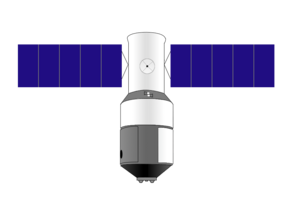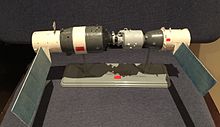Tiangong 1
| Tiangong 1 | |
|---|---|

|
|
| Dimensions in the final stage | |
| Length: | 10.4 m |
| Depth: | 3.35 m (without solar cells) |
| Volume: | 15 m 3 |
| Dimensions: | 8.5 t |
| Orbit | |
| Apogee height : | 362 km |
| Perigee height : | 355 km |
| Orbit inclination : | 42.77 ° |
| Rotation time : | approx. 92 min |
| COSPAR designation : | 2011-053A |
| Energy supply in the final stage | |
| Solar cell area: | 32.80 m 2 |
Tiangong 1 ( Chinese 天宮 一號 / 天宫 一号 , Pinyin Tiāngōng Yīhào - "Heavenly Palace 1") was the first space station in the People's Republic of China . It was developed by the Chinese Academy for Space Technology as part of the program of the same name and used as a space laboratory in China's manned space program . It served to research coupling maneuvers and long-term stays of space travelers. The launch on board a Langer Marsch 2 F launcher took place on September 29, 2011. When re-entering the earth's atmosphere in the night of April 1 to April 2, 2018, part of the space station burned up and the rest fell into the sea.
development
As early as the early 1970s, China had concrete plans to create a manned outpost in space. After economic and political barriers, however, the breakthrough came in 1992 with the space program called Project 921 , which concretizes China's manned space flight. After the Shenzhou spaceship was successfully introduced in the first project phase and brought almost to series maturity in the first seven missions, the second project phase provided for the construction of a space station. The implementation of successful rendezvous and coupling maneuvers is a prerequisite for such a project in space. With the docking system based on the Russian APAS , China has sophisticated docking devices.
Until the high-performance Langer Marsch 5 launcher , which can transport space station modules with a mass of up to 23 t into orbit, is completed, the relatively small Tiangong-1 module will offer a docking point for Shenzhou spaceships, solar generators for the supply of electrical energy and a limited one Pressurized living and working area for taikonauts as a prerequisite for exploring long-term stays in space. In the Tiangong program, the necessary fundamentals for the construction and operation of a space station are to be collected. Tiangong 1 was followed by Tiangong 2 in 2016 .
construction
Tiangong 1 was divided into two main components, the larger orbital module at the bow and the service module with a smaller diameter at the stern. The external structure of the space laboratory is reminiscent of the first Soviet Salyut space stations. The orbital module has an androgynous coupling unit comparable to the APAS-89 system for Shenzhou feeder vehicles and offered the visiting teams an air-conditioned living and working area equipped with life support systems. On the non-accessible service module there are two solar wings with a total span of 17 m for energy supply and there are fuel tanks and the engines for position control. The intended useful life was given as around two years.
The Langer Marsch 2F launcher, which also served as a carrier for the Shenzhou spaceships, limited the size and possible uses of the module. The diameter of Tiangong 1 is given as 2.8 m, the length as 9 m and the mass as 8.4 t, which corresponded to the maximum payload of this launcher. The mass of Tiangong 1 is less than half the mass of the first Soviet stations. Moreover, since a large part of the mass (about 3.5 t) to the service module is omitted, the usable space can (35 m³) in approximately the size of the Russian module Rasswet the International Space Station (ISS) compare.
By using a service module at the rear, the possibility of using a second axial coupling adapter for feeder vehicles was eliminated. Therefore, Tiangong 1 did not allow two Shenzhou spaceships to be coupled at the station at the same time. The meeting of crews or the unloading of an unmanned Shenzhou transporter by a crew was therefore not possible.
These apparent inadequacies are due to another circumstance. Spacecraft with the dimensions of the Tiangong type are to be used in future space stations as freighters with a total mass of around 13 t. A launch vehicle required for this is under development. Tiangong thus represented an important development step and not just an interim solution.
Missions
Tiangong 1 was launched on September 29, 2011 at 1:16 pm UTC from the Jiuquan Cosmodrome on a Long March 2F rocket. After an unmanned flight phase to test the flight and control properties, the space laboratory served as a docking target for the Shenzhou 8 unmanned transporter . After the successful coupling, tests of the flight characteristics of the unmanned complex were carried out and remote-controlled maneuvers were carried out.

On June 16, 2012, the manned spacecraft Shenzhou 9 took off , the crew of which entered the laboratory two days later after the successful coupling and put it into operation. The aim of the mission was primarily to test the system. These include above all the life support system, communication technology via geostationary relay satellites, gyroscope technology for position control, navigation, rendezvous and coupling technology as well as the behavior of the coupled system. Sources from the USA assumed that the station had mainly military targets, but this is not proven. Research work in weightlessness and earth observations were also on the agenda. For this purpose, Tiangong 1 is to be equipped with the necessary equipment for monitoring earthquakes, tsunamis and volcanic activities, among other things. International projects may also be carried out in collaboration with ESA .
After the crew of Shenzhou 9 undocked on June 24, 2012, some experiments and tasks that had been started were continued automatically. During the Shenzhou 10 Mission , Tiangong 1 was manned a second time from June 11 to 23, 2013.
After the manned phases, the space station was used for earth observation and research until March 2016. The successor Tiangong 2 was launched on September 15, 2016.
visibility
Due to its size, the Tiangong 1 space station could also be observed with the naked eye from Earth and achieved an apparent brightness of up to −2.7 mag. Because of the low inclination of 43 °, it only reached a small height above the horizon, seen from Germany.
crash
The Chinese space agency reported on March 21, 2016 that there is no longer any radio contact with Tiangong 1 and that the space station will therefore later burn up in the earth's atmosphere . Apparently, contact had already been lost on March 16, 2016, which made a targeted crash over an ocean impossible.
Due to air friction, the orbit height of Tiangong 1 gradually decreased until it entered a denser atmosphere. The time of re-entry and thus the exact location of the crash depended on the changing density of the high atmosphere and on the orientation of the space station and could not be precisely predicted until the end.
On April 2, 2018 at around 02:16 a.m. Central European Summer Time (00:16 UTC), Tiangong 1 entered the Earth's atmosphere over the South Pacific and broke into several parts. According to the US Air Force, parts that had not burned out fell into the sea about 100 kilometers northwest of Tahiti .
A few hours before the crash, the Fraunhofer Institute for High Frequency Physics and Radar Technology FHR in Wachtberg near Bonn was able to take the last high-resolution radar images of Tiangong 1 at an altitude of 160 km with the TIRA space observation radar.
Web links
- Chinese space program 921 in Raumfahrer.net (August 2003)
- Chinese space station in Raumfahrer.net (August 2003)
- Sinodefence.com: TianGong 1 Spaceflight Mission
- Space Daily: Tiangong Space Lab Spurs China Space PR Blitz (Summary of possible flight dates, November 2010, English)
Individual evidence
- ↑ Daniel Maurat, Günther Glatzel: China starts its first space station. In: raumfahrer.net. September 29, 2011, accessed September 30, 2011 .
- ↑ ESA: Monitoring (almost) complete. April 1, 2018, accessed on April 1, 2018 (English): "ESA's space debris team provided their final estimate for reentry, forecasting a window of about four hours between 23:00 UTC on April 1 to 03:00 UTC on April 2 (01:00 CEST on April 2 to 05:00 CEST on April 2). "
- ↑ a b aerospace.org: Tian Gong 1 reentry. April 2, 2018, archived from the original on March 22, 2018 ; Retrieved on April 2, 2018 (English, UTC = CEST - 2 hours): "Tiangong-1 was predicted to reenter the Earth's atmosphere on April 2nd, 2018 00:30 UTC ± 1.7 hours. The reentry has been confirmed as 2018/04/02 00:16 UTC. Reentry occurred in the Pacific Ocean. "
- ↑ Tang Yuankai: Palaces in Heaven. Beijing Review, March 24, 2009, accessed May 15, 2009 .
- ^ Günther Glatzel: Chinese Tiangong 1 space station manned. In: raumfahrer.net. June 18, 2012, accessed June 21, 2012 .
- ↑ Craig Covault: China readies military space station - launch coincides with shuttle phaseout. In: Spaceflight Now. March 2, 2009, accessed May 15, 2009 .
- ^ Sun: China's Shenzhou-8 spacecraft to carry bio sample for European Space Agency. Xinhua March 8, 2009, archived from the original March 11, 2009 ; accessed on May 15, 2009 .
- ↑ Rui C. Barbosa: China launches three person crew on Shenzhou-10. In: nasaspaceflight.com. Retrieved June 11, 2013 .
- ↑ China's 1st space lab Tiangong-1 ends data service. In: xinhuanet.com. March 21, 2016, accessed March 22, 2016 .
- ↑ Rui C. Barbosa: China launches Tiangong-2 orbital module. In: nasaspaceflight.com. September 15, 2016, accessed September 15, 2016 .
- ↑ Chris Peat: Tiangong 1- Information. In: Heavens-Above. Retrieved September 30, 2011 .
- ↑ to http://www.satflare.com (UTC) 02/04/2018 00:17:00
- ↑ China's 1st space lab Tiangong-1 ends data service. In: xinhuanet.com. March 21, 2016, accessed October 19, 2017 .
- ↑ Martin Holland: Tiangong 1: Chinese space station before uncontrolled crash. In: heise.de. October 13, 2017. Retrieved October 19, 2017 .
- ↑ China's Tiangong-1 to fall to Earth late 2017. In: xinhuanet.com. September 14, 2016, accessed October 19, 2017 .
- ↑ FAQ on the re-entry of Tiangong 1. In: esa.int. Retrieved March 28, 2018 .
- ^ Tiangong-1: Defunct China space lab comes down over South Pacific. BBC News, April 2, 2018, accessed April 2, 2018 .
- ↑ Helga Rietz: The Chinese space station "Tiangong-1" burns up over the South Pacific in Neue Zürcher Zeitung from April 2, 2018
- ↑ Researchers from Fraunhofer FHR accompany re-entry of the Chinese space station Tiangong-1 - Fraunhofer FHR. Retrieved April 8, 2018 .
- ↑ Fraunhofer FHR on Twitter . In: Twitter . ( twitter.com [accessed April 8, 2018]).



